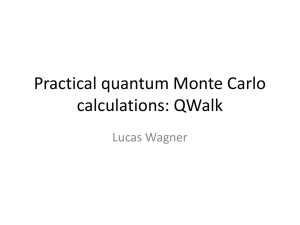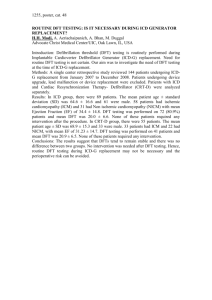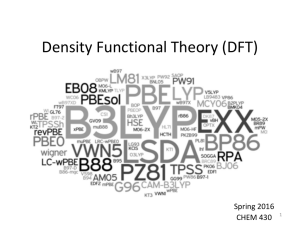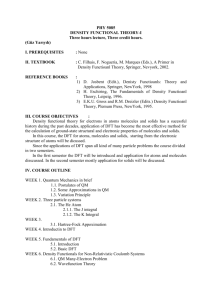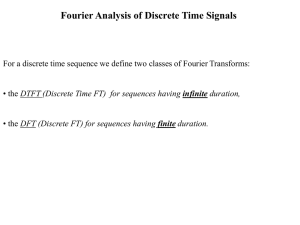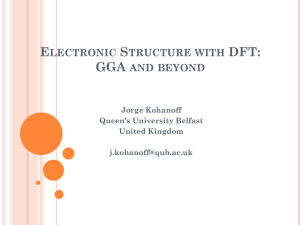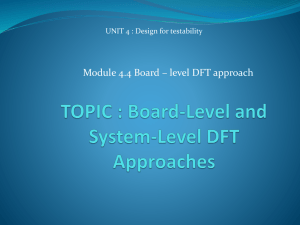slides
advertisement
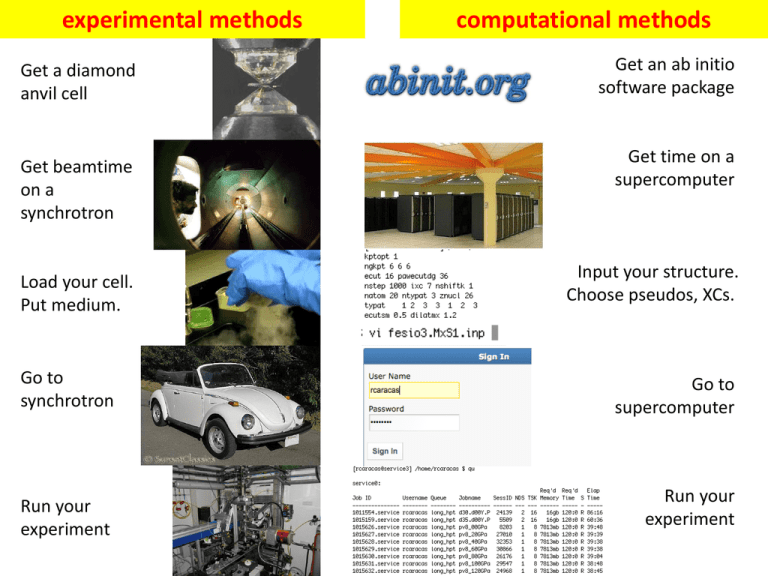
experimental methods Get a diamond anvil cell Get beamtime on a synchrotron Load your cell. Put medium. Go to synchrotron Run your experiment computational methods Get an ab initio software package Get time on a supercomputer Input your structure. Choose pseudos, XCs. Go to supercomputer Run your experiment What is it hard to calculate ? Transport properties: thermal conductivity, electrical conductivity of insulators, rheology, diffusion Excited electronic states: optical spectra (=constants?) Width of IR/Raman peaks, Melting curves, Fluid properties What we can calculate ? Electronic properties: orbital energies, chemical bonding, electrical conductivity Structural properties: prediction of structures (under extreme conditions), phase diagrams, surfaces, interfaces, amorphous solids Mechanical properties: elasticity, compressibility, thermal expansion Dielectric properties: hybridizations, atomic dynamic charges, dielectric susceptibilities, polarization, non-linear optical coefficients, piezoelectric tensor Spectroscopic properties: Raman spectra with peak position and intensity, IR peaks Dynamical properties: phonons, lattice instabilities, prediction of structures, thermodynamic properties, phase diagrams, thermal expansion A set of N particles with masses mn and initial positions Xn t: Xt Xt (=V) Xt(=A) m Compute new F then F = ma t+1: Xt+1 Xt+1 Xt+1 m Repulsive zone Attractive zone Two-body potentials or pair potentials Lennard-Jones Morse Buckingham 6 20 sij=2 sij=2.5 4 15 2 10 t12 0 t6 0 -2 0.5 1 1.5 2 2.5 3 3.5 4 t12 5 t6 R R 0 0 -4 -6 -5 -10 0.5 1 1.5 2 2.5 3 3.5 4 Multibody potentials Vij(rij) = Vrepulsive(rij) + bijkVattractive(rij) 2 body 3+ body Force fields – very good for molecules Many other examples: CHARMM, polarizable, valence-bond models, Tersoff interatomic potential http://phycomp.technion.ac.il/~david/thesis/these2.html Non-empirical = first-principles or ab initio - the energy is exactly calculated - no experimental input + - transferability, accuracy, many properties small systems Schrödinger equation time-dependent ¶ H (t ) | y n (t ) >= i | y n (t ) > ¶t time-independent [- 2 Ñ + U (r ) | y n >= En | y n > 2 2m En Eigenvalues |y n > Eigenstates Kinetic energy of the electrons External potential Schrödinger equation involves many-body interactions Wavefunction |y n > -contains all the measurable information -gives a measure of probability: |y n > < y n |y n >= y *y ~ many-particle wavefunction: depends on the position of electrons and nuclei scales factorial For a system like C atom: 6 electrons : 6! evaluations = 720 For a system like O atom: 8 electrons : 8! evaluations = 40320 For a system like Ne atom: 10 electrons: 10! Evaluations = 3628800 For one SiO2 molecule: 30electrons+3nuclei= 8.68E36 evaluations UNPRACTICAL! DENSITY FUNCTIONAL THEORY - What is DFT ? - Codes - Planewaves and pseudopotentials - Types of calculation - Input key parameters - Standard output THEORETICAL ASPECTS PRACTICAL ASPECTS - Examples of properties: - Electronic band structure - Equation of state - Elastic constants - Atomic charges - Raman and Infrared spectra - Lattice dynamics and thermodynamics EXAMPLES What is DFT Idea: one determines the electron density (Kohn, Sham in the sixties: the one responsible for the chemical bonds) from which by proper integrations and derivations all the other properties are obtained. INPUT Structure: atomic types + atomic positions = initial guess of the geometry There is no experimental input ! What is DFT What is DFT E[n(r )] = Ts [n(r )] + Eext [n(r )] + Ecol [n(r )] + Exc [n(r )] Kinetic energy of noninteracting electrons Energy term due to exterior Coulombian energy = Eee + EeN+ ENN Exchange correlation energy Electron spin: Decrease Increases energy n(r ) = N ò d r2 ò d r3...ò d rNy (r , r2 , r3 ,...., rN )y (r , r2 , r3 ,..., rN ) 3 3 3 * Exc: LDA vs. GGA LDA = Local Density Approximation GGA = Generalized Gradient Approximation Non- Exc = ò n(r )e xc (r )dr Exc = ò n(r )e xc (r , Dr )dr Flowchart of a standard DFT calculation Initialize wavefunctions and electron density Compute energy and potential E[n(r )] = Ts [n(r )] + Eext [n(r )] + Ecol [n(r )] + Exc [n(r )] n(r ) = N ò d 3r2 ò d 3r3...ò d 3rNy * (r , r2 , r3 ,...., rN )y (r , r2 , r3 ,..., rN ) Update energy and density Check convergence Print required output In energy/potential In forces In stresses Crystal structure – non-periodic systems Point-defect “big enough” Surface Molecule Input key parameters - pseudopotentials Valence electrons computed self-consistently Semi-core states Core electrons pseudopotential Input key parameters - pseudopotentials Pseudo-wavefunction All electron wavefunction Input key parameters - pseudopotentials Input key parameters - pseudopotentials localized basis planewaves Planewaves are characterized by their wavelength = 2p/G frequency f = w/2p period T = 1/f = 2p/w velocity v = /T = w/k wavevector G angular speed w planewaves The electron density is obtained by superposition of planewaves Input key parameters - K-points Limited set of k points ~ boundary conditions after: http://www.psi-k.org/Psik-training/Gonze-1.pdf PRACTICAL ASPECTS: Properties Electronic properties: electronic band structure, orbital energies, chemical bonding, hybridization, insulator/metallic character, Fermi surface, X-ray diffraction diagrams Structural properties: crystal structures, prediction of structures under extreme conditions, prediction of phase transitions, analysis of hypothetical structures Mechanical properties: elasticity, compressibility Dielectric properties: hybridizations, atomic dynamic charges, dielectric susceptibilities, polarization, non-linear optical coefficients, piezoelectric tensor Spectroscopic properties: Raman and Infrared active modes, silent modes, symmetry analysis of these modes Dynamical properties: phonons, lattice instabilities, prediction of structures, study of phase transitions, thermodynamic properties, electron-phonon coupling Values of the parameters How to choose between LDA and GGA ? - relatively homogeneous systems LDA - highly inhomogeneous systems GGA - elements from “p” bloc LDA - transitional metals GGA - LDA underestimates volume and distances - GGA overestimates volume and distances - best: try both: you bracket the experimental value Values of the parameters How to choose pseudopotentials ? - the pseudopotential must be for the same XC as the calculation - preferably start with a Troullier-Martins-type - if it does not work try more advanced schemes - check semi-core states - check structural parameters for the compound not element! Values of the parameters How to choose no. of planewaves and k-points ? - check CONVERGENCE of the physical properties Values of the parameters - check CONVERGENCE of the physical properties ecut (Ha) -12.045 Total energy (Ha) -12.05 15 20 25 30 35 40 45 50 -12.055 -12.06 -12.065 -12.07 -12.075 -12.08 ecut (Ha) 0 -5 15 -10 -15 -20 -25 -30 -P (GPa) -35 -40 -45 -50 20 25 30 35 40 45 50 Usual output of calculations (in ABINIT) Log (=STDOUT) file detailed information about the run; energies, forces, errors, warnings,etc. Output file: simplified “clear” output: full list of run parameters total energy; electronic band eigenvalues; pressure; magnetization, etc. Charge density = DEN Electronic density of states = DOS Analysis of the geometry = GEO Wavefunctions = WFK, WFQ Dynamical matrix = DDB etc. DFT codes http://dft.sandia.gov/Quest/DFT_codes.html http://www.psi-k.org/ DFT codes: A B I N I T ABINIT is a package whose main program allows one to find the total energy, charge density and electronic structure of systems made of electrons and nuclei (molecules and periodic solids) within Density Functional Theory (DFT), using pseudopotentials and a planewave basis. ABINIT also includes options to optimize the geometry according to the DFT forces and stresses, or to perform molecular dynamics simulations using these forces, or to generate dynamical matrices, Born effective charges, and dielectric tensors. Excited states can be computed within the Time-Dependent Density Functional Theory (for molecules), or within Many-Body Perturbation Theory (the GW approximation). In addition to the main ABINIT code, different utility programs are provided. First-principles computation of material properties : the ABINIT software project. X. Gonze, J.-M. Beuken, R. Caracas, F. Detraux, M. Fuchs, G.-M. Rignanese, L. Sindic, M. Verstraete, G. Zerah, F. Jollet, M. Torrent, A. Roy, M. Mikami, Ph. Ghosez, J.-Y. Raty, D.C. Allan Computational Materials Science, 25, 478-492 (2002) A brief introduction to the ABINIT software package. X. Gonze, G.-M. Rignanese, M. Verstraete, J.-M. Beuken, Y. Pouillon, R. Caracas, F. Jollet, M. Torrent, G. Zerah, M. Mikami, P. Ghosez, M. Veithen, V. Olevano, L. Reining, R. Godby, G. Onida, D. Hamann and D. C. Allan Z. Kristall., 220, 558-562 (2005) Sequential calculations one processor at a time Parallel calculations several processors in the same time These are Gflops / second (~0.5 petaflop) = millions of operations / second 1 flop = 1 floating point operation / cycle Itanium 2 @ 1.5 GHz ~ 6Gflops/sec = 6*109 operations/second RUN MD CODE Jmol exercise: http://jmol.sourceforge.net/ EXTRACT RELEVANT INFORMATION: Atomic positions Atomic velocities Energy Stress tensor VISUALIZE SIMULATION (ex: jmol, vmd) PERFORM STATISTICS Ex: coordination in forsteritic melt at mid-mantle conditions C-O Si-O

